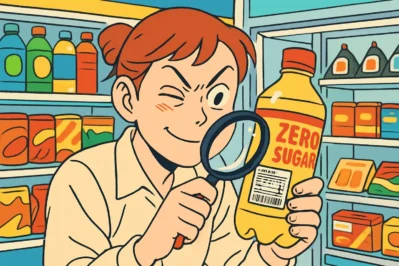Is It Really ‘Zero’? Master Korean Food Labels!
Hello, everyone! Welcome to [Maeil Hangeul], your go-to blog for leveling up your Korean skills!
Have you ever stood in a Korean convenience store, surrounded by amazing snacks, but felt a little lost? You want to buy that delicious-looking treat, but you’re not sure what’s inside. You’re not alone! Today, we’re going to become smart shoppers by learning how to read Korean food safety labels.
This is super useful, especially now! Lately in Korea, the “Zero Sugar” (제로 슈거) and “Healthy Pleasure” (헬시플레저) trends are huge. You’ll see tons of drinks, cookies, and jellies labeled “Zero.” But are they really zero? Let’s learn the Korean you need to find out for yourself and shop with confidence!
Key Expressions You Must Know
Here are the essential words you’ll find on almost every Korean food package.
- 한국어 표현: 유통기한
- 발음 [로마자]: Yu-tong-gi-han
- 영어 뜻: Expiration Date / “Sell-by” Date
- 상세 설명: This is one of the most important words to know! It literally means “distribution period.” You should always check this date before buying anything. Important: Recently, Korea has started using a new term, 소비기한 (So-bi-gi-han), which means “use-by” or “consumption” date. You might see both, but always make sure you’re eating food before this date passes!
- 한국어 표현: 영양정보
- 발음 [로마자]: Yeong-yang-jeong-bo
- 영어 뜻: Nutrition Facts
- 상세 설명: This is the heading for the nutrition table. Here you can find information about calories (칼로리), sodium (나트륨), carbohydrates (탄수화물), and of course, sugar (당류)! If you’re checking if your “Zero” drink is truly sugar-free, this is where you look for “당류 0g”.
- 한국어 표현: 원재료명
- 발음 [로마자]: Won-jae-ryo-myeong
- 영어 뜻: List of Ingredients
- 상세 설명: This means “raw material names.” It’s the full list of what’s inside the product. It’s essential for anyone with allergies or dietary restrictions (like vegan or halal). The ingredients are listed in order from the highest quantity to the lowest.
- 한국어 표현: – 함유
- 발음 [로마자]: – Ham-yu
- 영어 뜻: Containing / Contains
- 상세 설명: This is a suffix that means “contains.” You’ll often see it on the front of packaging. For example, “단백질 12g 함유” (Dahn-baek-jil 12g ham-yu) means “Contains 12g of protein.” The opposite, “무함유” (mu-ham-yu), means “does not contain” or “-free,” like in “설탕 무함유” (seol-tang mu-ham-yu), meaning “sugar-free.”
Example Dialogue at a Convenience Store
Let’s see how these words are used in a real conversation! Two friends, A and B, are looking at the new “Zero” version of a popular drink.
A: 와, 이 복숭아 아이스티 새로 나왔나 봐! 마셔볼까?
(Wa, i bok-sung-a a-i-seu-ti sae-ro na-wat-na bwa! Ma-syeo-bol-kka?)
(Wow, looks like this peach iced tea is new! Should we try it?)
B: 잠깐만, 유통기한부터 확인하자. 음, 괜찮네. 근데 이거 진짜 제로 슈거 맞아?
(Jam-kkan-man, yu-tong-gi-han-bu-teo hwa-gin-ha-ja. Eum, gwaen-chan-ne. Geun-de i-geo jin-jja je-ro syu-geo ma-ja?)
(Hold on, let’s check the expiration date first. Hmm, it’s fine. But is it really zero sugar?)
A: 어디 보자… 뒤에 영양정보에 ‘당류 0g’이라고 쓰여 있어.
(Eo-di bo-ja… dwi-e yeong-yang-jeong-bo-e ‘dang-ryu 0g’ i-ra-go sseu-yeo i-sseo.)
(Let me see… On the back, the nutrition facts say ‘Sugars 0g.’)
B: 좋아! 그럼 원재료명에 설탕 대신 다른 게 들어갔겠네. 마셔보자!
(Jo-a! Geu-reom won-jae-ryo-myeong-e seol-tang dae-sin da-reun ge deu-reo-gat-gen-ne. Ma-syeo-bo-ja!)
(Great! Then I guess they used something else instead of sugar in the ingredients list. Let’s drink it!)
Culture Tip & Trend Deep Dive
As we mentioned, the “Healthy Pleasure” (헬시플레저) trend is massive in Korea right now. It’s all about enjoying being healthy, not seeing it as a stressful chore. This is why “Zero” products are so popular!
- K-Pop Idol Influence: You’ll often see K-pop idols drinking zero-calorie iced teas or sodas in their live streams or behind-the-scenes videos. This has made these drinks incredibly trendy, especially among young Koreans.
- Become a Real Pro: Want to look like you really know your stuff? Even if a product says “Zero Sugar,” check the 원재료명 (ingredients list). You will likely see artificial sweeteners like ‘아스파탐’ (aspartame) or ‘수크랄로스’ (sucralose). Knowing this little detail will make you seem just like a local! Reading the label helps you make the healthiest choice for you.
Let’s Review & Practice!
Great job today, everyone! We learned some vital Korean words for smart and safe shopping: 유통기한 (expiration date), 영양정보 (nutrition facts), and 원재료명 (ingredients list). Now you can pick your K-snacks like a pro!
Ready for a quick quiz?
- If you want to check if a snack contains milk (우유) because you are allergic, where should you look?
(Hint: There are two possible answers!) -
You pick up a yogurt and see the date “2024.10.25”. This date is the __________.
Now it’s your turn! Go find a Korean product in your home and try to find these words. Leave a comment below telling us the 유통기한 of your favorite Korean snack!
See you next time at [Maeil Hangeul]






